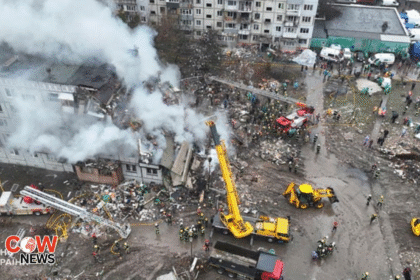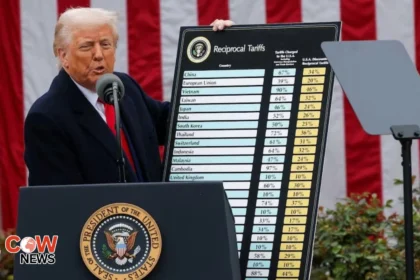Amir Shehzad (Editor TheCOWNews)
Reports that the Taliban government may have handed over Afghanistan’s strategically vital Bagram Airbase to the United States have ignited a fresh wave of debate across the region. The claim, unverified officially by either the Taliban or the U.S. government, centers around the recent landing of an American C-17 military aircraft at Bagram, allegedly carrying senior CIA officials, military vehicles, and equipment.
While the Taliban administration quickly dismissed the claims, the incident has renewed focus on America’s post-withdrawal intentions in Afghanistan, raising questions about covert diplomacy, strategic realignments, and broader regional implications involving China, Russia, Iran, and Pakistan.
According to local media sources, the U.S. aircraft reportedly flew from Al Udeid Air Base in Doha, Qatar, and landed at Bagram Airbase via Pakistani airspace. Among the passengers was allegedly CIA Deputy Director Michael Ellis, along with other intelligence officials and logistical equipment.
These developments come amidst comments from former U.S. President Donald Trump, who recently described Bagram as a key asset in countering China’s influence. Trump claimed that during the U.S. military’s chaotic withdrawal in August 2021, billions of dollars in military hardware—including 777,000 rifles and 70,000 armored vehicles—were left behind, making Afghanistan one of the largest military surplus sellers in the world.

In a cabinet meeting last month, Trump reiterated his assertion that the U.S. should have retained Bagram not for Afghanistan, but to monitor China’s nearby nuclear missile production facilities, located just an hour’s flight away. He labeled the base as “one of the largest and most powerful airbases in the world,” boasting robust infrastructure, including 12,000-foot runways and reinforced hangars.
Responding to these claims, Taliban spokesperson Zabihullah Mujahid strongly refuted the allegations, branding them as “propaganda.” He asserted that the Islamic Emirate of Afghanistan maintains full control over Bagram Airbase and that no Chinese or American military personnel are present. “There is not a single armed Chinese individual here, nor do we have any such agreement,” Mujahid said, criticizing the spread of misinformation by global leaders.
Similarly, Afghanistan’s Deputy Foreign Minister spokesperson, Zia Ahmad Takal, dismissed the report, labeling it false. The Pentagon has yet to issue an official comment, although one U.S. defense official reportedly told The Independent that there is “no current American military presence in Afghanistan.”
Located just north of Kabul, Bagram Airbase served as the command center for U.S. and NATO forces for nearly two decades. It was central to operations against the Taliban and al-Qaeda during the U.S.-led war in Afghanistan. After the rapid U.S. withdrawal in August 2021, the Taliban took control of the sprawling facility, which includes two runways, hardened aircraft shelters, a 50-bed hospital, and a passenger lounge.
The base’s sheer scale and strategic location have made it a focal point in discussions about the future of U.S. and foreign influence in Afghanistan. Trump has frequently cited the base’s value, claiming that its loss gave leverage to adversarial powers, particularly China.
The alleged return of senior CIA personnel to Bagram—if verified—could signal a shift in U.S. policy from direct military intervention to a more covert intelligence-driven approach. Analysts suggest that Washington may be seeking to re-establish an intelligence network in Afghanistan amid rising threats from extremist groups like ISIS-K (Islamic State Khorasan Province), which remains active in parts of the country.
A possible reactivation of Bagram would also allow the U.S. to conduct surveillance operations over nearby regions, especially Western China, Iran, and parts of Central Asia—areas of growing geopolitical concern for Washington.
While the Taliban’s immediate rejection of the claims suggests no formal agreement is in place, the possibility of clandestine coordination cannot be ruled out entirely. The evolving relationship between global powers and the Taliban government, which still lacks international recognition, may involve off-the-record negotiations.
So far, major regional stakeholders including Pakistan, Iran, China, and Russia have remained officially silent on the matter. However, experts believe that each of these countries is carefully monitoring the situation.
For China, any return of U.S. assets in Afghanistan poses a strategic challenge. Beijing has invested heavily in Afghanistan’s infrastructure and natural resources and is concerned about American surveillance or disruption of its Belt and Road Initiative in the region.
Russia, which has maintained a cautious yet pragmatic relationship with the Taliban, may interpret any American return as the opening salvo in a new Cold War scenario. Moscow has been increasing its own influence in Central Asia and would be wary of renewed U.S. presence in its backyard.
Iran, sharing a long border with Afghanistan, would likely view any U.S. re-engagement as a direct threat. Tehran has historically opposed American military presence in neighboring countries and could react diplomatically or through proxy channels.

Pakistan, which has played a pivotal role in Afghanistan’s political landscape and continues to manage a complex relationship with both the Taliban and the U.S., would find itself in a delicate balancing act. While Islamabad may welcome renewed security cooperation with Washington against terrorist groups, it would be wary of backlash from Taliban allies or domestic political factions.
Within Afghanistan, public reaction has been mixed. Some segments, especially in urban areas and conflict-prone regions, believe a limited U.S. intelligence presence could help curb rising violence and insurgent threats. Others view any foreign return as a precursor to another prolonged conflict or proxy war.
The Taliban’s firm denial of any foreign military presence appears to be aimed at maintaining legitimacy among its base and signaling sovereignty to the international community. However, if any secret agreements do exist, they could backfire politically if exposed.
Should the Bagram airbase indeed be reactivated under U.S. coordination—even partially—it could mark the start of a new strategic era in Afghanistan. The shift would reflect the broader global realignment, where intelligence, surveillance, and strategic positioning take precedence over conventional military deployments.
From Washington’s perspective, re-establishing a foothold in Afghanistan, even unofficially, might be necessary to counter the expanding influence of China and Russia, and to monitor militant activity in the region.
On the other hand, for the Taliban, cooperating—either overtly or covertly—with U.S. intelligence could be a calculated risk to gain international legitimacy and financial aid, without formally ceding sovereignty.
The murky developments surrounding Bagram Airbase illustrate how Afghanistan remains a crucial chessboard in global geopolitics. The interplay of denial, speculation, and unconfirmed reports underscores the opaque nature of international diplomacy in a post-war Afghanistan.
Whether this alleged development leads to greater stability or new conflicts will depend on how transparently involved parties act and how regional stakeholders respond. For now, Bagram continues to symbolize Afghanistan’s past—and perhaps its uncertain future.







